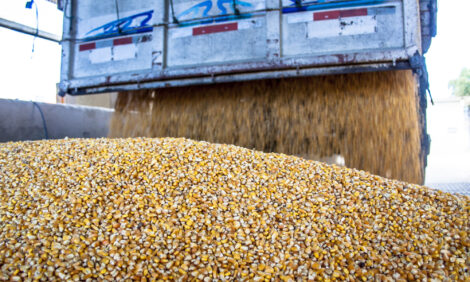



U.S. Slaughter Last Week: The lower slaughter numbers we've expected have arrived
CANADA - Jim Long's Weekly Pork Commentary reviewing the US hog slaughter figures. Jim Long President, Baconmaker Genetics / Wood Lynn Farms, Inc. |
The last 3 weeks have had over 5% fewer hogs come to slaughter this year compared to last. The decline averages 100,000/week. This positive news has more credence when you consider Iowa/Minnesota slaughter weights dropped 2 lbs the week of August 30. There's no way hogs are just backing up. The market inventory is smaller and it is current.
This week will be interesting. Packer margins have improved and we expect higher cash prices. Most of the time packers show little discipline in maintaining margins and we expect they will chase hogs with higher bids.
We believe that after several months of retail and food service buyers being told there would be fewer hogs but fewer hogs not materializing, these buyers have to be shown the reality of fewer hogs before they react with more aggressive purchasing. That's how it worked with beef recently. Last year from June on, the cattle industry expected fewer slaughter cattle year over year. But the price did not respond until there actually were fewer cattle coming to slaughter and that wasn't until last November. Since then, cattle have risen from 64 cents to 85 cents, the rise amounting to almost $250/head. It may be hard for hog producers to believe, but price surges can happen.
| U.S. Weekly Hog Slaughter (millions) | ||
| Category | 2002 | 2003 |
| Week of Aug 23 | 1.966 | 1.887 |
| Week of Aug 30 | 2.029 | 1.908 |
| Week of Sep 06 | 1.845 | 1.741 |
| 3-week total | 5.840 | 5.536 |
As nice as it is to actually see, the lower slaughter hog numbers we have had the last 3 weeks has not been a surprise. The first major decrease in monthly pig crops in this hog cycle was in February. Six and a half months later---and right on schedule---that pig crop came to market in August. We should expect more of the same. Each month's pig crop since February has been at least 3% smaller than the year before. This should guarantee slaughter hog numbers being significantly lower year over year for the next several months.
Continental Hog Market
To see the total picture on hog supply we have to look at the combined production capacity of the U.S. and Canada's breeding herds. From last June to this fall (projected) the combined breeding herd looks like this:
| Combined U.S./Canada Breeding Herd | |
| Time Frame | Breeding herd |
| Jun-Jul 2002 | 7.708 million hd |
| Mar-Apr 2003 | 7.468 million hd |
| Sep-Oct 2003 | 7.400 million hd |
The March-April actual of 7.468 was almost 250,000 fewer head than June-July of 2002. It was also the smallest combined U.S./Canadian breeding herd on record. Our projection is that the September-October combined herd will be smaller still. The point is, it isn't just the breeding herd in the U.S. that is getting smaller. The combined breeding herd of Canada and the U.S. is getting smaller and fewer sows will mean fewer hogs and higher prices for at least a year. Demand will play its usual part and demand for pork will be stronger for 3 reasons:
- Population increase: The human population in the U.S. and Canada grows 3-3.5 million/year.
- At current per capita consumption we need 1 million more hogs each year to meet this demand increase.
- Pork exports: They will continue to grow.
- Higher beef prices and lower beef supply will support pork demand.
Too Many Feeder Pigs & SEWs Recently Is Not What It Seemed
Looked like too many pigs/too few barns. And it was. But only sort of.... Feeder pig and SEWs have been under pressure with both recently being under $20. For several weeks supply seemed to outstrip barn capacity in the Midwest. Many wondered if it was an increase in total supply because that's what it looked like. Turns out, though, that it wasn't barns that were at capacity. It was lagoons in North Carolina that were at capacity. Those full lagoons temporarily prevented the barns they served from being filled with pigs. So North Carolina barns sat empty and their pigs were shipped to Midwest barns instead. Now, though, lagoon levels in North Carolina have dropped and the number of pigs being diverted to the Midwest has decreased. Feeder pig and SEW prices should begin to increase.
The End Is Near
The psychology in the production side of the hog industry is negative. Losing money too long will do that. Today, 32-cent hogs don't work for anyone. Many are wondering about their future and we know of several producers saying "enough is enough" and quitting. Who can blame them? The economics of the last 5 years have been tough.
No one knows the future for sure but if you are contemplating quitting now, disconnect the anguish of production loss from the consideration of the money. The market place, for solid fundamental reasons, is upbeat and sees money ahead. On the Chicago Mercantile Exchange, October is 10 cents higher than cash at roughly 42 cents/lb live. One month next summer has hit 66 cents lean. We've got a discouraged production sector but bullish speculators. Say what you like about speculators but we think their vision here is 20/20. Speculators look to the future and, tracking USDA inventory data, know there will be fewer hogs.
If you are concerned about the future, look at Options. Use them to lock in downside on prices but leave the upside in place.
| Published with permission from |
Information provided by |
Source: Jim Long, www.baconmaker.com. Reproduced courtesy Farms.com - 8th September 2003







